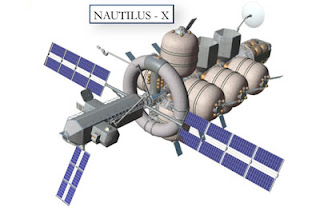Engineering An Asteroid Close Approach
I've been posting lately about the threat large asteroids pose to Earth, human missions to smaller asteroids, and the opportunities that will exist in the next few decades to do so. Up until this point, my analysis has been mostly for my own education and amusement, but I'd like to make a suggestion now which I haven't seen published in the literature or seriously discussed in either NASA working groups or even in the space advocacy community.
I'd like to suggest that we need not wait for an appropriate asteroid to come within range of Earth and plan human missions around just those opportunities - we can engineer a perfect close approach.
Next year, at the start of June, the asteroid 2009 BD will pass within the orbit of the Moon. Even though it is not a rare occurrence, few opportunities such as this have been identified, and realistically, no-one is going to be ready to send a human mission to an asteroid for years to come.
It seems a shame to let this close approach go to waste, with just 40m/s of tweaking, the orbit of 2009 BD could be changed to this:
(click to open the viewer)
The blue part indicates the part of the orbit which is within 20 lunar distances of Earth: over 965 days in the next 6 years. The delta-v required to change the orbit of this asteroid could be delivered by a single impulse, and the most advanced technology available to do that is to simply run into it.
Calculating how to change an asteroid's orbit has been an educational exercise which would not have been possible without the JPL Horizons system and the SPICE toolkit.
I'd like to suggest that we need not wait for an appropriate asteroid to come within range of Earth and plan human missions around just those opportunities - we can engineer a perfect close approach.
Next year, at the start of June, the asteroid 2009 BD will pass within the orbit of the Moon. Even though it is not a rare occurrence, few opportunities such as this have been identified, and realistically, no-one is going to be ready to send a human mission to an asteroid for years to come.
It seems a shame to let this close approach go to waste, with just 40m/s of tweaking, the orbit of 2009 BD could be changed to this:
The blue part indicates the part of the orbit which is within 20 lunar distances of Earth: over 965 days in the next 6 years. The delta-v required to change the orbit of this asteroid could be delivered by a single impulse, and the most advanced technology available to do that is to simply run into it.
Calculating how to change an asteroid's orbit has been an educational exercise which would not have been possible without the JPL Horizons system and the SPICE toolkit.



What would the mass or speed of the impacting object have to be to change the orbit of the asteroid? Would their be any risks or the asteroid veering off course and hitting either the Moon or Earth?
ReplyDeleteI found estimates that it's 10m in diameter which works out to about 700t at 2.6 g/cm^3. So something like a 7t mass @ 4 km/s would work assuming it's one big rock and not an agglomeration.
ReplyDeleteI can see the main issue being political. Imagine the headlines - "Scientists aim giant asteroid at Earth". 10m isn't big but it could cause very localized damage depending on its composition.
at 2.6g/cm^3 it'd have no chance of getting through the Earth's atmosphere. :)
ReplyDeleteI tend to use 3.3g/cm^3 for a "generic" asteroid.. but the metallic ones can be as high as 7.6g/cm^3.
That is a pretty clever idea and looks pretty doable to a guy with no technical experience.
ReplyDeleteI saw a comment over at Space Politics about capturing a NEO with a solar sail and taking it to a Lagrange point. Any thoughts?
So Trent, does that program tell you what part of the asteroid you would have to hit to make it change orbit? Much like pool and soccer, where you hit the ball is as important as how hard.
ReplyDeleteAnonymous, no, and we don't really have enough information about any NEOs to make that kind of call.. except possibly for 25143 Itokawa.
ReplyDeleteSo the assumption is just that you smack it with a delta-v that causes a particular trajectory change.. exactly how you do that is an exercise left to the future celestial pool player.
Thanks for the response.
ReplyDelete